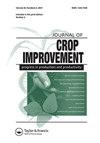Fresh sweet corn yield sensitivity to deficit nitrogen and water conditions
IF 1.5
Q3 AGRONOMY
引用次数: 2
Abstract
ABSTRACT Water and nitrogen (N) are the major limitations for maximizing crop yield. However, there has been no detailed examination of these limitations on fresh kernel yield in sweet corn (Zea mays L.). A two-year field study in Shiraz, Iran, was conducted to document sweet corn response to three soil-water regimes (irrigation to field capacity, and 80% and 60% of this amount) and five N fertilizer amounts (0, 75, 125, 175, and 225 kg N ha−1). Decreasing irrigation to 60% of field capacity resulted in yield decreases. The results showed that increasing N amounts increased fresh kernel yield to a maximum at 175 and 225 kg N ha−1. A highly positive, linear correlation was found between fresh kernel yield and kernel number formed per ear (R2 = 0.94), and also between kernel fresh yield and total crop mass (R2 = 0.88). Harvest index (HI) based on dry kernel weight varied between 0.20 and 0.41 in the two years with the lowest HI occurring in the 0 and 75 kg N ha−1 treatments.鲜甜玉米产量对缺氮和缺水条件的敏感性
水分和氮(N)是作物产量最大化的主要限制。然而,对甜玉米(Zea mays L.)鲜粒产量的这些限制还没有详细的研究。在伊朗设拉子进行了一项为期两年的实地研究,记录了甜玉米对三种土壤-水制度(按农田容量灌溉,灌溉量的80%和60%)和五种氮肥用量(0、75、125、175和225 kg N ha - 1)的响应。灌溉减少到田间容量的60%,导致产量下降。结果表明,施氮量的增加使鲜粒产量在175和225 kg N ha−1时达到最大值。鲜粒产量与每穗形成的粒数呈高度正线性相关(R2 = 0.94),鲜粒产量与作物总质量呈高度正线性相关(R2 = 0.88)。以干粒重为指标的收获指数在0.20 ~ 0.41之间变化,以0 ~ 75 kg N ha - 1处理的收获指数最低。
本文章由计算机程序翻译,如有差异,请以英文原文为准。
求助全文
约1分钟内获得全文
求助全文
来源期刊

Journal of Crop Improvement
Multiple-
CiteScore
3.30
自引率
7.70%
发文量
42
期刊介绍:
Journal of Crop Science and Biotechnology (JCSB) is a peer-reviewed international journal published four times a year. JCSB publishes novel and advanced original research articles on topics related to the production science of field crops and resource plants, including cropping systems, sustainable agriculture, environmental change, post-harvest management, biodiversity, crop improvement, and recent advances in physiology and molecular biology. Also covered are related subjects in a wide range of sciences such as the ecological and physiological aspects of crop production and genetic, breeding, and biotechnological approaches for crop improvement.
 求助内容:
求助内容: 应助结果提醒方式:
应助结果提醒方式:


